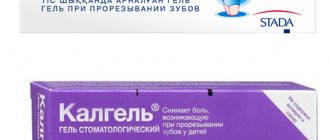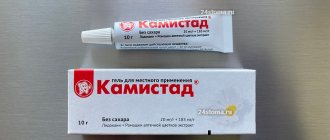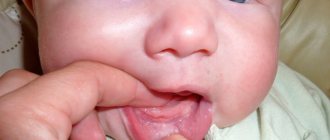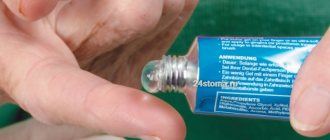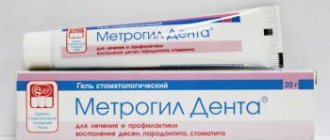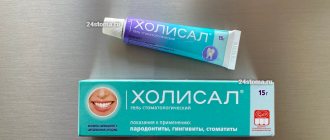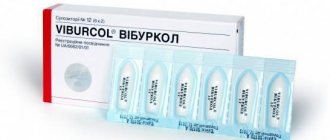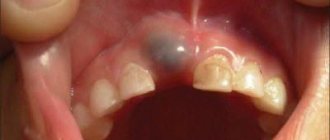Instructions for use
Teething in a child is a natural physiological process, the beginning of which many parents look forward to. The first baby teeth begin to appear at 6-8 months, and by 2.5-3 years all 20 teeth usually grow in. For many babies, this period is quite painful and difficult. In rare cases, teething does not show any symptoms, and parents discover new teeth by accident. It is a natural desire to protect your child from pain and discomfort. Fortunately, when teething, you no longer need to resort to traditional medicine methods and spend sleepless nights calming the baby. Modern dental products come to the rescue when teething in children, which have an analgesic and anti-inflammatory effect.
Pharmacology and pharmacodynamics
The medication has an antimicrobial effect and also has anti-inflammatory and analgesic effects.
The active ingredient choline salicylate relieves pain and inflammation at the site of application of the gel. The analgesic effect lasts for an average of 4-7 hours.
The second active element has a powerful antiseptic effect. Effectively copes with harmful bacteria.
The structure of the ointment promotes its rapid absorption into tissues, reaches the nerve endings in a short time and remains on the oral mucosa for a long time. Almost does not enter the blood.
Prevention of stomatitis in children
Prevention of stomatitis comes down to following basic hygiene rules. It is necessary to teach your child to regularly wash their hands and brush their teeth twice a day. In this case, the brush and paste should be selected in accordance with his age. If the child is still too small, then parents should help with hygiene procedures. It is also recommended to periodically wash toys, disinfect pacifiers and bottles, and keep the house clean.
Learn about other oral diseases
Scurvy Oral thrush Pathological tooth wear Stevens-Johnson syndrome
What does Cholisal help with?
The gel is able to cope with inflammatory processes occurring in the oral cavity and various injuries. The drug should be taken for the following conditions:
- stomatitis;
- mechanical injuries and other damage resulting from wearing prostheses;
- for severe pain, as well as for prophylactic purposes after dental surgery;
- teething in babies;
- gingivitis.
When to suspect teething
The first teeth - the lower central incisors - can begin to erupt as early as three months, but in most cases their time comes at the age of 6-7 months.
Starting from this age, when symptoms appear that make it possible to suspect a cold or intestinal infection (we will talk about them later), first of all you should think about the fact that it could be teething and how to help the baby. Only after providing pain relief assistance, call a doctor and examine the child as prescribed. Teething occurs approximately according to this schedule:
| What kind of teeth | Time of eruption of baby teeth (months) | |
| Incisors | Lower central | 6–7 |
| Upper central | 8–9 | |
| Upper side | 9–11 | |
| Lower side | 11–13 | |
| Indigenous | The first (immediately behind the fangs) upper | 12–15 |
| First top | 12–15 | |
| Second (large) bottom | 24–30 | |
| Second top | 24–30 | |
| Fangs | Upper | 16–18 |
| Lower | 18–20 | |
It is especially important to know how to numb teething teeth in the following cases:
- at the age of 16–20 months, when the fangs grow: these are the teeth whose eruption is worst tolerated by children;
- if the first incisors began to appear closer to 11–13 months: the baby may have problems with the jaw bones, so any teeth he develops will be very painful;
- if the child was already born with defects of the dental-jaw system.
How to use Cholisal gel
The instructions indicate that the ointment is for external use only. It should be applied exclusively to the affected area of the mouth.
The product should be applied 20 minutes before or after meals. You can also rub the ointment in before going to bed. The procedure can be repeated up to 3 times a day. It will be enough for a child to use 0.5 cm, and for an adult – 1 cm.
If a person suffers from periodontal disease, then the ointment can be placed in the gum pockets that appear or effective compresses can be made.
How is stomatitis treated in children?
Every parent should understand that there is no single algorithm for treating stomatitis in a child. As we have already found out, many factors can contribute to the onset of inflammation. This means that treatment of stomatitis in a child must begin with eliminating the main cause that caused inflammation of the oral mucosa. Only a doctor can select complex therapy, based on the symptoms of the disease, the child’s age and other individual characteristics. Treatment usually includes taking medications, using local remedies for stomatitis in children (gels, ointments, applications), maintaining good hygiene, diet and sleep. Depending on the type of stomatitis, various medications are prescribed. Thus, for allergic stomatitis, antihistamines may be recommended, for herpetic stomatitis - antiviral drugs, and for aphthous stomatitis - antibiotics. It is strongly not recommended to resort to self-treatment, because the wrong choice of medication can aggravate the child’s condition.
Adverse reactions and overdose
In some cases, after direct contact of the oral mucosa and the ointment, undesirable reactions may occur in the form of a burning sensation and tingling sensation. Such reactions are normal and disappear on their own after a few minutes. In rare cases, allergies may occur.
If serious side effects occur, you should stop using the gel and tell your doctor.
There are no cases of drug overdose. The ointment should not be swallowed; it is intended for external use only. If part of the medicine gets inside, then you need to rinse the stomach and, if necessary, begin symptomatic treatment.
What are the reasons for stomatitis in children?
Various factors can contribute to the development of stomatitis in a child, for example, insufficient hand and oral hygiene, the habit of gnawing objects found on the floor. It is worth understanding that, unlike adults, the mucous membrane in children is more delicate and vulnerable, and the immune system is not yet strong enough to resist infections. In addition, at an early age, the process of salivation has not yet fully formed. Because of this, the child’s mucous membrane often dries out, cracks appear, into which infection enters and inflammation begins. Other causes of stomatitis include long-term use of medications, neuropsychiatric disorders, lack of proper treatment for ARVI and other diseases, unfavorable living conditions, etc.
Reviews about Cholisal
Most reviews about the use of the drug by adults and children are positive. The gel is able to quickly and effectively eliminate pain and inflammation and cools the affected area. If you use the medicine at night, the effect will last almost until the morning. Also has an antipyretic effect. For many, the advantage is that the composition does not contain lidocaine, to which many have adverse reactions and allergies.
There are many rave reviews from patients who had stomatitis. Within 3-5 minutes after application, you can notice a significant improvement in the condition, pain disappears, and after 15-20 minutes the inflammation is relieved. If you apply compresses before bed, then after a couple of days the signs of stomatitis will almost completely disappear.
The gel is sold in pharmacies. It can be bought without a doctor's prescription.
What symptoms indicate that teeth are being cut?
The first reason to pay attention to whether teeth are cutting, and how to help determine it, are the general symptoms:
Behavior change
The child either pushes his parents away or asks to be held. He often cries, refuses his favorite toys or pacifiers, and throws them on the floor.
In addition, the baby loses his appetite. When starting to eat, the child feels discomfort in the teething area, so the baby eats in small portions, and, having started to eat, cries after a short period of time. Sleep is disturbed: pain in the gum prevents him from falling asleep.
Most children indirectly show that they are teething, and every parent should know how to help. They:
- chew any hard objects they can reach;
- often reach for the breast or bottle, while hardly eating, but rolling (or gnawing) the nipple or pacifier in the mouth.
In general, it is worth considering that teeth are being cut and how to help with this if the baby has become “unbearable” for no apparent reason.
Please note: these symptoms should not last longer than two to three days and should end with the appearance of a small area of tooth above the gum.
Increased salivation, chin irritation and wet cough
These are interrelated symptoms:
- Salivation increases as a result of three reasons:
- irritation of the gum tissue and the nerve endings located in it by the erupting tooth;
- physiologically - due to the baby adopting a new position for him - sitting, which coincides with teething;
- difficulty swallowing saliva.
- A wet cough is a consequence of a large amount of saliva. The baby still lies more often than sits, so saliva flows down the back wall of the throat and enters the respiratory tract. If the cough is caused specifically by teething, it occurs in the morning and is almost not observed during the day when the child is awake.
- Redness and rash on the chin also occur due to the abundance of saliva that flows onto the skin.
If you see such signs of teething in your child, how to relieve pain, read on.
Runny nose
The appearance of light, watery discharge from the nose is possible due to teething. This type of runny nose may be accompanied by sneezing, but ends within 3-4 days without complications. If the snot becomes yellow or green, or the cough gets worse and the child becomes lethargic, check with your pediatrician. In such a situation, the question “how to numb teething teeth”, as a rule, does not arise.
Changing the appearance of your gums
2–3 weeks before the eruption of a canine, incisor or molar, an enlarged blue area (hematoma) may appear on the gum. This is not accompanied by unpleasant symptoms, and the child behaves as usual.
A change in the appearance of the gums when the symptoms described above appear helps to understand that teeth are being cut and how to help - this is the most important question at the moment. In this case, the gum becomes reddish and swollen; touching it causes discomfort in the child and a desire to bite the object being touched. These local signs disappear after the tooth appears above the gum. Sometimes teething is accompanied by the release of a small amount of blood.
Controversial symptoms
Often, against the background of the eruption of incisors, canines or molars, the child experiences symptoms that are very reminiscent of some kind of infection - respiratory or intestinal:
- temperature rise above 37.5°C
- diarrhea;
- vomit;
- pain in the ear or maxillary sinus;
- lethargy.
Both the parents themselves and the pediatrician can associate these signs with teething. But in fact, the child needs examination. Because teething often coincides with ARVI or intestinal infection.
This is justified: immunological studies prove that immunity decreases physiologically during this period. That is, if previously a child could easily cope with a pathogenic microbe, now it is difficult to resist it.
To understand whether it is an infectious disease or teething and how to help, an examination by an ENT doctor is often enough. After examining the throat, nose and ears, he will tell you whether there are signs of inflammation there or not. If the ENT organs are in order, perhaps such symptoms are still associated with a dental problem.
Diarrhea that occurs against the background of teething requires consultation with an infectious disease specialist. Especially if loose stools are observed more than 3 times a day or are accompanied by an increase in temperature.
Release form, composition and packaging
◊ Dental gel
in the form of a colorless, transparent, homogeneous mass with the smell of anise oil.
| 1 g | |
| Choline salicylate | 87.1 mg |
| cetalkonium chloride | 0.1 mg |
Excipients: hyaetellose – 20 mg, methyl parahydroxybenzoate – 1.5 mg, propyl parahydroxybenzoate – 0.8 mg, glycerol – 50 mg, anise seed oil – 1.61 mg, ethanol 96% – 390 mg, water – up to 1000 mg.
Cholisal for seizures
Reasons for sticking in the corners of the mouth
Normally, the oral mucosa independently prevents the penetration of infection due to its structure. But with a decrease in immunity, this ability is significantly reduced. Therefore, angulitis in children and adults most often appears in the autumn-spring period (lack of vitamins), during colds and during exacerbation of chronic diseases (decreased immunity). There are many reasons for this:
• frequent damage to the mucous membrane of the corner of the mouth (banal injury to the corner of the mouth, frequent licking of the lips);
• disruption of the microflora of the oral cavity leading to seizures and other stomatitis;
• overdrying of lips in the wind makes the mucous membrane of the corners of the mouth more vulnerable;
• at a dentist appointment – when you have to keep your mouth wide open for a long time. The corner of the mouth becomes dry, its washing and banal wetting with saliva are impaired. Any touch, even gentle, to the mucous membrane of the corner of the mouth can be unpleasant or painful. Prevention of this is simple and banal - lubricate the corners of the mouth with Vaseline;
• after treatment with antibiotics. When the microflora of the whole body is disturbed;
• increased activity of Candida fungi;
Types of jam
Seizures in the corners of the mouth are caused by three types of microflora - bacterial (staphylococci and streptococci), Candida fungi and herpes.
Ideally, angulitis should be treated with means that will affect exactly the microflora that caused the seizure:
Treatment for jamming in the corners of the mouth
Treatment of a stuck mouth is, on the one hand, trivial, but on the other hand, it is not entirely simple. We have already found out that the main cause of jamming is microtrauma and microflora entering the mucous membrane. And it makes no difference whether it is foreign to the body or healthy, its own. And if the immune system is weakened, then it is not able to fight any microflora - neither its own nor the alien one. Any of them becomes pathological - negatively affecting. Therefore, the treatment for mouth jam is:
• simple prevention of jamming - do not use other people’s spoons and hygiene products (toothbrushes, etc.)
• in case of the first signs of mouth seizure, treat the inflammation of the corner of the mouth locally: with ointments, powders, etc.
Local treatment for jam consists of applying drugs to the corners of the mouth. Moreover, the treatment is step-by-step - first remove the pathogens, and then help the corners of the mouth recover. It’s better to start with:
• decoctions of chamomile, calendula
• in case of seizures against the background of dry, cracked lips, it is rational to lubricate them to moisturize them with oils (rosehip, sea buckthorn, olive, oil solutions of vitamins A and E)
• in case of long-term and ineffective treatment of jam, scrapings are made to determine the main microflora in the corners of the mouth. Most often these are staphylococci, streptococci and Candida fungi. And drugs are prescribed to target them specifically:
If the jam looks red, with a thick crust, then the cause is staphylococci or streptococci
Its treatment consists of applying antibacterial ointments:
• kamistad ointment or gel
• crushed streptocide tablet can be applied as a powder
If the jam is varnish-red or has a white coating, then Candida mushrooms are to blame
Then treatment with antifungal agents:
With herpes, seizures may appear on the lips
Treatment of herpetic angulitis is carried out with general treatment and place:
A universal remedy for the treatment of post all seizures is Cholisal gel. It is effective against bacteria, viruses and fungi.
When the acute phase of angulitis has passed, for faster healing, use the following:
General treatment for stuck lips
Increasing immunity and strengthening it:
vitamins of groups B, A and C in the form of vitamin complexes or an increase in the diet of foods containing them:
• B vitamins contain: milk, cheese, cottage cheese, broccoli, fresh peas, green beans, spinach and bran.
• Microelements in foods: peaches, pomegranates, nuts, parsley, asparagus, buckwheat, seafood, pumpkin seeds.
If seizures do not go away for a long time, you need to understand the common causes of decreased immunity, chronic diseases and influence them.
To treat a mouth jam, it is not necessary to take an antibiotic, or anything else, orally before or after a meal, and do not inject it intramuscularly with small or large syringes. It is enough to sprinkle or moisten it several times (depending on the drug you choose) directly into your mouth. And repeat everything as prescribed in the instructions for the drug for several days.
What if I go untreated? A rhetorical question. There will be no colossal harm, not counting cosmetic ones. Typically, seizures go away on their own in four to five days if the body receives energy and vitamins from somewhere (usually through food, but there are other non-traditional options). If you don’t have access to these resources, then write “lost”, and the jam will decorate your face until your immunity increases. Since Lomonosov also proved that “Nothing comes from nowhere and goes nowhere,” it becomes clear that the fight against binge eating will only end with an increase in the body’s immunity, to strengthen which it must be reinforced with something somewhere.
Lip jams treatment
Local treatment
The trick is to apply medications to the corners of the mouth. Moreover, the treatment is step-by-step - first remove the pathogens, and then help the corners of the mouth recover. It's better to start with:
- decoctions of chamomile, calendula,
- in case of seizures against the background of dry, cracked lips, it is rational to lubricate them to moisturize with oils (rose hips, sea buckthorn, olive, oil solutions of vitamins A and E),
- In case of long-term and ineffective treatment, scrapings are made to determine the main microflora in the corners of the mouth. Most often these are staphylococci, streptococci and Candida fungi. And drugs are prescribed to target them specifically:
If the jam looks red, with a thick crust, then the cause is staphylococci or streptococci
Its treatment consists of applying antibacterial ointments:
- methyluracil
- left-handed
- Kamistad ointment or gel
- You can apply a crushed streptocide tablet or ready-made liquid ointment (liniment) as a powder.
If the jam is varnish-red or has a white coating, then Candida mushrooms are to blame
Then treatment with antifungal agents:
- levorin ointment
- nystatin ointment
- Candida solution or ointment
With herpes, seizures may appear on the lips
Treatment of herpetic angulitis is carried out with general treatment and local:
- Gerpevir ointment
- Amiksin tablets
- Viferon
A universal remedy for treating almost all types of seizures is Cholisal gel. It is effective against bacteria, viruses and fungi.
Available in tubes of 10g and 15 grams.
When the acute phase of angulitis has passed, for faster healing, use the following:
- sea buckthorn oil
- rosehip oil
Possible unwanted effects
The instructions prescribe using the drug with caution during pregnancy and breastfeeding, that is, the product must be recommended by a specialist, which involves monitoring its use and abandoning the gel, if necessary.
Thus, domestic medicine does not prescribe treatment with Cholisal gel during the first trimester of pregnancy.
Complications and negative consequences when using Cholisal gel were observed by practicing doctors extremely rarely. However, increased individual sensitivity to the ingredients of the drug can manifest itself as:
- not a strong burning sensation in the areas where the product was applied;
- redness;
- itching
These side effects most often disappear within a few minutes.
However, when the first unwanted symptoms appear, experts recommend stopping using the gel, since the cause of an allergic reaction may be:
- salicylates;
- anise oil,
as well as other ingredients included in the product.
In addition, dentists advise using the optimal amount of the drug during procedures, avoiding overdose.
In addition, it should be taken into account that the use of cholisal with other analgesics, anti-inflammatory drugs, antipyretic syrups can increase the concentration of active substances in the body, and an excess of antibiotics and antiseptics can also cause an allergic reaction.
Considering the free sale of Cholisal gel in pharmacies, before purchasing and using the drug, you should consult with a specialist, which will allow you to use the modern combined action product most effectively.
Metrogyl denta for stomatitis
In order to quickly cure stomatitis, you need to start therapeutic actions as early as possible. Metrogyl denta for stomatitis is an effective drug that helps stop a spreading infection at an early stage. Metrogyl gel adheres well to the mucous membrane without being absorbed into the deep layers of tissue, thereby capturing and limiting foci of inflammation. In addition to its antimicrobial effect, the drug relieves burning and itching well, the effect lasts up to 12 hours, after which the gel can be applied again.
Metrogil denta for stomatitis has the following advantages and positive characteristics:
Attention!
To make information easier to understand, these instructions for use of the drug “Gel for Stomatitis” have been translated and presented in a special form based on the official instructions for medical use of the drug. Before use, read the leaflet included directly with the medication.
The description is provided for informational purposes and is not a guide to self-medication. The need to use this drug, the prescription of the treatment regimen, methods and doses of the drug are determined solely by the attending physician. Self-medication is dangerous for your health.
